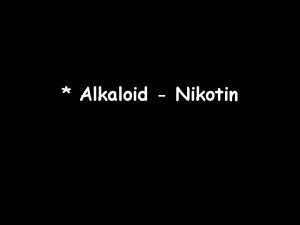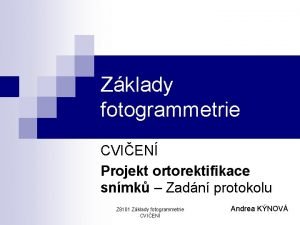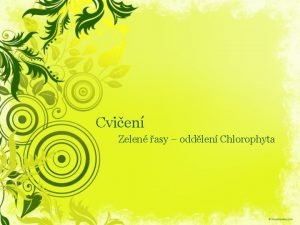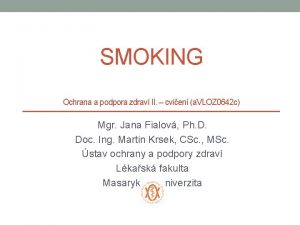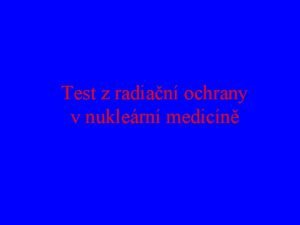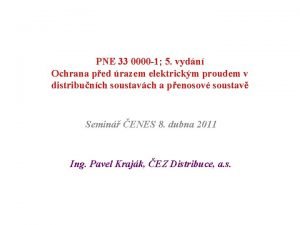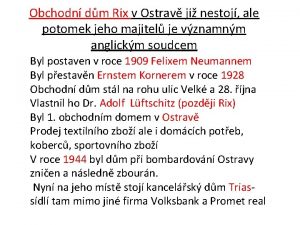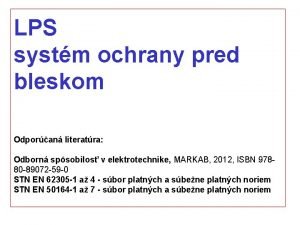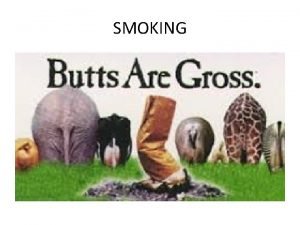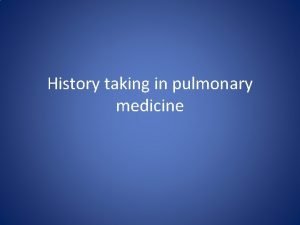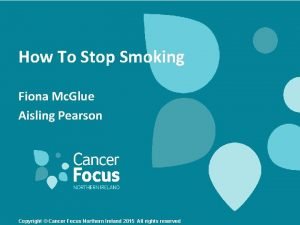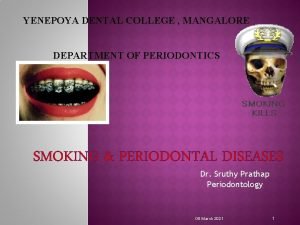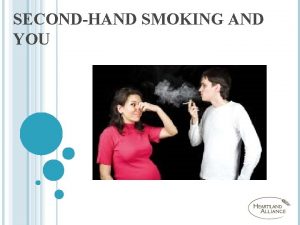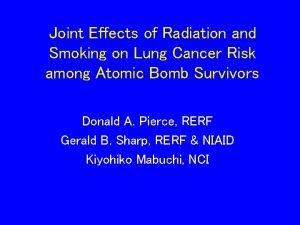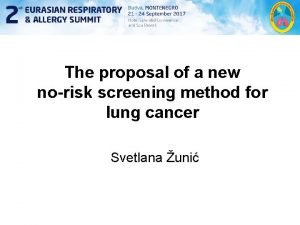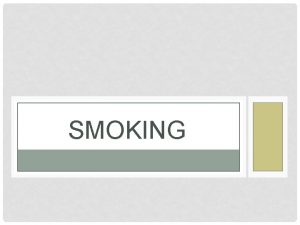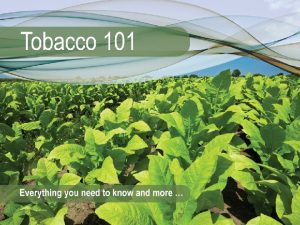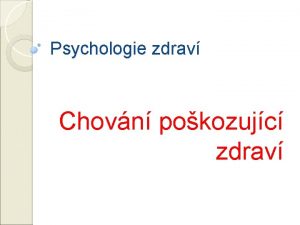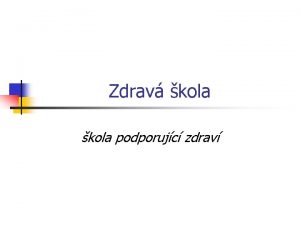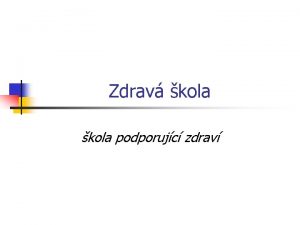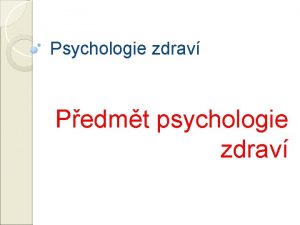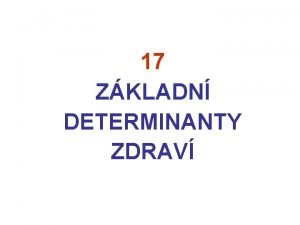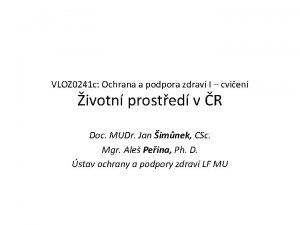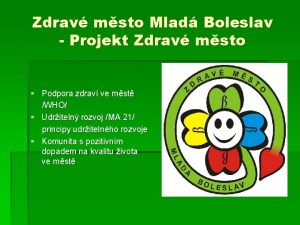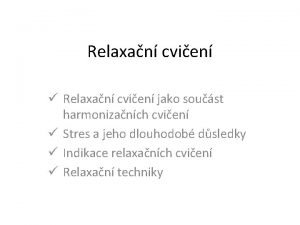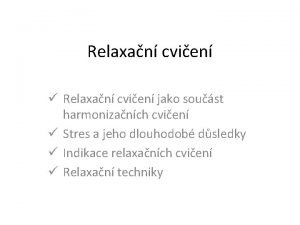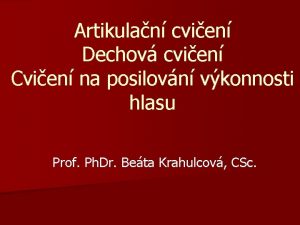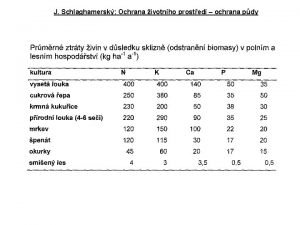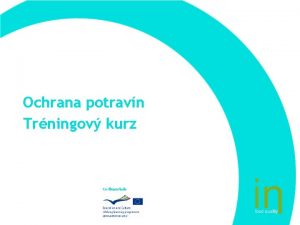SMOKING Ochrana a podpora zdrav II cvien a





































- Slides: 37

SMOKING Ochrana a podpora zdraví II. – cvičení (a. VLOZ 0642 c) Mgr. Jana Fialová, Ph. D. Doc. Ing. Martin Krsek, CSc. , MSc. Ústav ochrany a podpory zdraví Lékařská fakulta Masarykova univerzita

Smoking • Inhalation of tobacco smoke, most effective way for intoxication by nicotine • 1 cigarette 1 - 3 mg of nicotine, 1 cigar cca 10 mg of nicotine • Inhaling into mouth only - absorbs 5% of nicotine, deep inhalation – absorbs 70%, very deep inhalation with holding breath - 95% of nicotine • Tobacco products for smoking (with nicotine-rich leaves of a tobacco plant) : 1. cigarette, 2. cigar and cigarillos, 3. pipe tobacco, 4. water pipe tobacco

Tobacco plants Nicotiana tabacum Nicotiana rustica L. French ambassador in Portugal, Jean Nicot de Villemain sent tobacco and seeds to Paris in 1560

Nicotine • Plant alkaloid (from plant family Solanaceae) • Human lethal dose - cca 60 mg • Stimulating effects in nervous system C 10 H 14 N 2 • Increase digestive tract activity, increase blood pressure, cardiac acceleration, vasoconstrictor effects, related tissue and organ hypoxia • It is not a carcinogen itself • Its metabolites do • E. g. NNK - nicotine-nitrosamine ketone: a strong mutagen and a carcinogen present in tobacco smoke, naturally occurring in tobacco leaves of industrially treated tobacco crops in the presence of light

Side effects of nicotine

Effect of nicotine on dopaminergic neurons

Urinary metabolites of nicotine, quantified as average percentage of total urinary nicotine

Smokeless use of nicotine • Electronic cigarettes, electronic pipe (nikotin liquid) - IQOS + Heets (Marlboro) (tobbaco inside) • Smokeless tobbaco products: - oral, chewing, snuff tobacco (like a Snus or dipping tobacco)

Tobacco smoke • Approximately 1500 different chemicals are detected in the smoke of pipe and cigar tobacco, in cigarette smoke even more than 5000, of which: • Over 30 of them are contaminants of polluted air • Approximately 70 of these are considered as human carcinogens • WHO: Tobacco smoke is human carcinogenic mixture • A - arsenic - a toxic element, used since ancient times as a rat poison (soil, pesticides) • B - Benzene - carcinogenic, naturally occurring in oil, benzopyrene - a highly carcinogenic and mutagenic substance, a typical product of incomplete combustion (1/2 of exposure from cig. ) • D - dioxins (a group of the strongest known poisons), DDT (a very effective insecticide, used to kill harmful insects until the late 1960 s , then banned in most countries) - both highly persistent • F - Formaldehyde - formerly used as an insecticide to kill moths, as a disinfectant and sterilizing agent, as a part of chipboard adhesives or in the manufacture of carpets • K - cadmium - heavy metal, strongly cumulative mainly in kidneys, chemically similar to Zn - blockages and changes in biochemistry cycles (insulin cycle) - hydrogen cyanide - one of the most poisonous gases (used in gas chambers during WW II, as well as a mouse poison) • N - nickel - a highly toxic element, highly teratogenic • O - Lead - a toxic element, especially dangerous for children - causes slowing of mental development and behavioral disorders • TSNA - Tobacco-specific nitrosamines - a group of highly cancer-causing substances that are present only in tobacco products, are involved in many types of cancer, can damage reproductive organs (nitrite + AA)

The most famous components of tobacco smoke • Carbon monoxide (CO) - toxic gas; preferential binding to hemoglobin molecules - decreases the amount of oxygen transferred by blood, significantly lower overall oxygenation of the organism. The main component of exhaust gases. • Nitrogen dioxide (NO 2) - highly toxic gas, airway inflammation - from light forms to lung edema. Involved in the formation of acid rains and the formation of photochemical smog. • Nitric oxide (NO) - toxic gas, corrosive in the presence of moisture. In the human body it is formed in the cardiovascular and nervous system, it affects the vasodilatation, the signal molecules, the neurotransmitter function; in medicine, use in the release of smooth muscle cramps, during asthma. At higher doses - heart weakness. Releases in exhaust gases and co-operate in acid rain. • Tar - a mixture of chemicals (predominantly toxic and cancer-causing) such as polycyclic aromatic hydrocarbons (PAHs) or aromatic amines; has a dense oily or greasy consistency. In tobacco smoke it is dispersed in the form of an aerosol, 90% of which is deposited in the lungs of the smoker, 10% returns with exhaled smoke back to the atmosphere in its immediate vicinity.

The most famous components of tobacco smoke

Health consequences of inhalation of tobacco smoke It is involved in origin of about 25 diseases Increased morbidity Premature mortality 50% of smokers die as a result of smoking Half of them, ie 25% die prematurely Differences in mortality among smokers and non-smokers are statistically significant after 20 years of smoking WHO: SMOKING IS THE MOST IMPORTANT PREVENTABLE (!) CAUSE OF DEATH IN THE WORLD

The British Doctors' Study 1951 - 2001 The longest prospective study - addressed more than 34, 000 British doctors (more than 2/3 get involved). Basic hypothesis - "Smoking is a major cause of lung cancer". In 19511971, the difference in life span of smokers and non-smokers was 5 years, after another 20 years 8 years, and the latest study found a 10 -year loss of life for British doctors-smokers as compared to lifetime non-smokers.

WHO: Global pandemic Smokers mortality: • CVD (cardiovascular d. ) 1, 69 mil/rok • CHOPD (Chronic Obstructive Pulmonary Disease) 970 tisíc/rok • Lung cancer 850 tisíc/rok

Another smoking-related illness • Ca of throat, mouth and larynx, Ca of intestines and rectum, Ca • • of urinary tract, Ca of breast and cervix Reproductive health Dental health Ulcer disease of the stomach and duodenum Intestinal polyps, Crohn's disease Immune disorders Macular degeneration of the retina and cataracts Hyposmia, earlier presbyakusia Psychiatric disorders • Worsening of healing of wounds and skin lesions, increased wrinkle formation • Psoriasis • Tremor

Smoking during pregnancy and prenatal exposure to tobacco smoke Intrauterine retardation (lower birth weight and length, smaller head and chest circumference) More common birth defects The withdrawal symptoms of children after childbirth Sudden Infant Death Syndrome - SIDS Behavioral Disorders, Socialization, Learning difficulties - ADHD CVD programming (obesity, irreversible changes in serum lipid spectrum)

Active and passive smoking - Active - "Voluntarily" • Passively - involuntarily - First-hand smoke • Second-hand smoke - Main stream - Temperature 800 -900 ° C - O 2 content around 16% (environmental tobacco smoke) • Side stream • Temperature 600 ° C • The content of O 2 about 2% • Higher content of some chemicals (acetone, acrolein, formaldehyde, ammonia, cadmium, CO, naphthalene, toluene, polonium 210. . . )

Residual smoke: Third-hand smoke • The form of passive smoking - "third-hand" • Specific smoking product: residues of nicotine and other chemicals from smoke and products of their interaction with other substances in the (polluted) environment (ozone, nitric acid) + fine dust (from the environment, from combustion of cigarettes) • Persistent toxic and carcinogenic substances - nitrosamines • Contamination of surfaces in interiors • Furniture, textiles, objects in houses and cars • The most vulnerable group – children (immature biological structures, faster breathing frequency, lower breath zone, specific habits - climbing on four, licking hands. . . )

Prevalence of tobacco smoking In the Czech Republic: The overall prevalence of cigarette smoking over the past 15 years: about 30% By gender male 36%, women 26% By age - under 15: up to 33%, 15 -24 years: 43%, 2544 years: 33%, 45 -64 years: 28%, over 65: 20% Use of tobacco products other than cigarettes around 2 - 2. 5%; e-cigarettes 1. 7% Source: SZÚ 2013: Use of tobacco and alcohol in the Czech Republic in 2012 In the world: http: //www. who. int/gho/tobacco/use/en/

Definition of smoking by WHO • Regular smoker - at least 1 cigarette / day • Occasional smoker - less than 1 cigarette / day • Former smoker - at the time of the study he/she has not smoked for at least 6 months, smoked more than 100 cigarettes during his/her life / was a regular smoker for more than 6 months • Non-smoker - He has not smoked more than 100 cigarettes in his lifetime • Defined by the International Union Against Cancer (UICC) in Lyon 1976

Tobacco abuse and addiction • Nicotine addiction - Dg. F 17 according to the International Classification List of Diseases: "Mental and behavioral disorders caused by the use of tobacco" • In children and adolescents - rapid development of physical dependence (brain development not complete: limbic structures = emotional component of behavior, frontal cortex = cognitive component, proven cognitive deficit in adulthood) • Consequences at the age of 30 -60: Reduction of audioverbal learning, reduction of visual spatial memory, reduction of cognitive abilities, reduction of physical performance, reduction of general intelligence, reduction of postural stability and motor dexterity.

The origin and development of the disease • Three stages of disease development: - Psychosocial stimuli - Strengthening "psychic addiction„ - Syndrome of addiction - in 60 -80% of smokers Addiction syndrome - a set of behavioral, cognitive and physiological phenomena that develops after repeated use of the substance, and which typically includes i. c. so-called withdrawal symptoms.

Withdrawal symptoms • craving - craving, urge, desire bad mood, depression, irritability to aggression, anger, frustration, anxiety insomnia, fatigue, headaches increased appetite nausea, constipation, flatulence decrease in blood pressure, dizziness less ability to concentrate and manage stressful situations

Diagnosis of addiction • In the Czech Republic, it is underestimated - in hospitalized patients only 1. 5% diagnosed with Dg. F 17 • In general, the diagnosis of tobacism is also mentioned in the Czech legislation: Act No. 65/2017 Coll. • Diagnosis in practice: the procedure is not well defined, recommended combination of assessment of typical addiction traits (eg by the American Psychiatric Society using tobacco more than a year + min. 2 positive responses for typical dependencies) and assessment of the degree of addiction - Fagerström test and Minnesota's school of withdrawal symptoms (https: //www. ncbi. nlm. nih. gov/pmc/articles/PMC 2527730/)

Fagerstrom Test of Nicotine Dependence • • • • • • 1. How soon after you wake up do you smoke your first cigarette? After 60 minutes 0 31 -60 minutes 1 6 -30 minutes 2 Within 5 minutes 3 2. Do you find it difficult to refrain from smoking in places where it is forbidden? No 0 Yes 1 3. Which cigarette would you hate most to give up? The first in the morning 1 Any other 0 4. How many cigarettes per day do you smoke? 10 or less 0 11 -20 1 21 -30 2 31 or more 3 5. Do you smoke more frequently during the first hours after awakening than during the rest of the day? No 0 Yes 1 6. Do you smoke even if you are so ill that you are in bed most of the day? No 0 Yes 1

Program of 5 A‘s for Smoking Cessation • Ask • Advice • Assess (Assess the willingness to stop, or to motivate) • Assist (Help – NRT - nicotine replacement therapy, centre) • Arrange follow up (Schedule checks)

Treatment of the physical component of the addiction: minimizing withdrawal symptoms Substitutional - Nicotine replacement therapy (NNT) Pharmacotherapeutical - Bupropion, Varenicline Behavioral (psychotherapy) Alternative (lack of evidence of efficacy, according to EBM can not be recommended as an effective treatment option)

Nicotine replacement therapy NRT • minimizes withdrawal symptoms • CI (relative): CV disease, pregnancy, childhood - even in these cases always healthier than smoking • NE: throat burns, hiccups, indigestion, nausea, palpitations, headache • Dosage: Individual setting, about 3 months to stay at the starting dose, further 3 months - of gradual dose reduction after 2 weeks

Forms of NRT • Chewing gums 2 mg, 4 mg (260, -) the right technique !!! • Nicorette plaster 5, 10, 15 mg, 16 h (570, -) Niquitin CQ 7, 14, 21 mg, 24 h (460, -) • Inhaler 10, 15 mg (360 - 400, -) • Sublingual tablets: 2 mg • Oral spray 1 dose 1 mg of nicotine, pack of 150 mg of solution (370, -) • Pastilles 1. 5 mg, 4 mg • Orodispersible film They differ in pharmacokinetics, the possibility of combining of continuously acting patches/plasters with other forms influencing peaks.

Farmakotherapy • It reduces the intensity of withdrawal symptoms similar to NRT, but without nicotine • The need for long-term treatment: at least 3 -6 months, individually and much longer • Mostly good tolerance, beware of interaction with drugs used in psychiatry • Bupropion • Vareniclin • Cytisin • Combination options with NRT

Combined treatment • NRT - different forms combined among themselves • Bupropion + NRT • Varenicline + NRT All the above mentioned ideally combine with behavioral psychotherapy

Treatment of behavioral addiction • An integral and necessary part of the curing/cessation process !!! • Psychosocial complex approach • Advice - should be provided by an expert - trained specialist • Not yet so available in the Czech Republic • Network of available services: • Smoking cessation counseling • Smoking cessation centers

Harm reduction • Efforts to reduce the health risks of smoking • Can not talk about "healthier" smoking, it's just a reduction of toxicity • Apply this approach only after failure of verified methods • Principle: Permanent reduction of the number of smoked cigarettes (most commonly NRT or pharmacotherapy) • E-cigarettes, vaporizers: Recommended as harm reduction products or for smoking cessation, but many experts disagree • Current lifestyle change (nutrition, movement, etc. ) • It is absolutely necessary to reject the hookah/water pipe as a means of HR, the harmfulness for active and passive smokers similar to the cigarette

Prevention of smoking • Comprehensive approach: • Changing attitudes and viewing the society on smoking • Education, information, enlightenment • availability of tobacco for children and teenagers (legislation and its enforceability, economic instruments, . . . ) • Beware of the opposite effect, especially among young people !!! • Solving problem of smoking with other forms of risky behavior • Necessary part of prevention - helping to quit smoking

Legislation in prevention - Smoking restriction - Restrictions of advertisement - Terms and rules of production and distribution of tobacco products - Conditions of labelling and warning - Act No. 65/2017 Coll. , On the protection of health against harmful effects of addictive substances - Decree No. 37/2017 Coll. , On e-cigarettes. . . - Differences between countries, including within the EU

Economic and social aspects of smoking • High spending on health care • Receipt of finance from the taxation of tobacco products into the state budget • Problems: strong tobacco lobbies (? ), Nontransparent transfers of funds (? ) - no clear arguments • The tendency of smoking in the socially weaker groups, getting poorer, the vicious circle, the economic and social interdependence - the connection to the social and health system

Thanks for your attention!
 Model tanjira
Model tanjira Umetnik mora biti zdrav
Umetnik mora biti zdrav Alkaloid nikotin
Alkaloid nikotin Cvien
Cvien Cvien
Cvien Zoospory
Zoospory Cvien
Cvien Radiační ochrana test
Radiační ochrana test Ochrana stavovcov
Ochrana stavovcov Orol skalný
Orol skalný Pne 33 0000-6
Pne 33 0000-6 Kalamity a prirodne hrozby na slovensku
Kalamity a prirodne hrozby na slovensku Obchodní dům rix ostrava
Obchodní dům rix ostrava Ochrana proti blesku
Ochrana proti blesku Ochrana významných minerálov
Ochrana významných minerálov 62305-3
62305-3 Ochrana ip
Ochrana ip Podpora podnikania na slovensku
Podpora podnikania na slovensku Olsko
Olsko Przyczepa konar jg2 światła
Przyczepa konar jg2 światła Chatzy smoking
Chatzy smoking Black fly in your chardonnay
Black fly in your chardonnay Type of smoking
Type of smoking Curious george smoking a pipe
Curious george smoking a pipe Smoking history taking
Smoking history taking Fiona stopped smoking last year
Fiona stopped smoking last year Conclusion of smoking
Conclusion of smoking Nadia barak
Nadia barak Lynn curlee smoking angels
Lynn curlee smoking angels Creating supportive environments smoking
Creating supportive environments smoking Whats passive smoking
Whats passive smoking True and false questions about smoking
True and false questions about smoking Smokers radiation
Smokers radiation Do you mind clean
Do you mind clean Conclusion of smoking
Conclusion of smoking Active vs passive smoking
Active vs passive smoking Smoking bamboo treatment
Smoking bamboo treatment Smoking cessation learning objectives
Smoking cessation learning objectives


